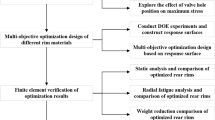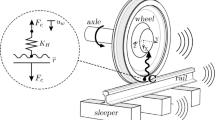Abstract
In order to achieve the wheels lightweight design, the optimization software Isight integrated with SolidWorks and Abaqus. The parametric three-dimensional model of the rim section is built based on SolidWorks, the finite element method is used to analyze stress and displacement distributions in a variable cross-section rim subject to the conjoint influence of radial load and inflation pressure. The optimization methods which combined multi-island genetic algorithm (MIGA) with NLPQL algorithm is used for exploration. By adjusting control parameters of the rim shape quality is optimized. The results show that the optimization effect is good.
F2012-E09-009
Access provided by Autonomous University of Puebla. Download conference paper PDF
Similar content being viewed by others
Keywords
1 Introduction
Automobile Wheels are rotating parts between the tires and axle, which are important safety components in the vehicle driving system, plays a significant role in bearing, steering, driving and braking. Studies have shown that the energy saving effect of automobile rotating parts lightweight is equivalent to 1.2–1.3 times that of non-rotating parts. The equal strength design of wheels is an important way to achieve the wheels lightweight. The equal strength rim’s thickness varies according to the load size rim cross-section suffered, after a strong spinning the fatigue strength of the rim and resistance to stress corrosion can improve; therefore it has small quality, high strength, and good security. The equal strength rim research is still at the starting stage, the relationship between the change of cross-section and carrying capacity is not clear, resulting in a lack of theoretical guidance in variable cross-section rim design.
In recent years, domestic and foreign popular optimization design method provides new rim design ideas, that is, first through the initial design method to design the geometry of the rim, and then the cross-section can be expressed as the design parameters, performance is expressed as a objective function changing along with the design parameters [1]. So optimization design process is to select design parameters for the best performance based on the objective function. This process is an automated process, without manual intervention, therefore, the design cycle greatly shortens. According to the new rim design method, this article uses multi-island genetic algorithm (MIGA) combined with sequential quadratic programming (NLPQL) optimization method to generate the optimal rim model.
2 Design Parameters of Variable Cross-Section Rim
The sketch of constant cross-section rim (LT2745) consists of the arc and line, variable cross-section wheel rim design method is to use the spline curve instead of the arc lines, and add size constraints to achieve parametric modeling, so rim section shape can vary by changing design parameters. Take the cross-section control parameters D1, D7, D6 D2, D10, D3, D14, D15, D5, D17, D4, D19 and D18 as design parameters to optimize, as shown in Fig. 1.
3 Stress Analysis in a Rim Subject to the Radial Load
Under the influence of a radial load, the tensile strength of the rim exerts a profound influence on durability, that is, fatigue life of the automotive wheel [2]. In an actual automotive wheel, the radial load is applied at the bead seat with the tire. The distributed pressure is loaded directly onto the bead seat in the model used in this analysis. The pressure is assumed to have a cosine function distribution mode with a central angle of 36° in a circumferential direction [3], as shown in Fig. 2. Also, it is assumed that the contact patch width corresponds to the area of contact over the bead seat, as shown in Fig. 2. These calculations are based on segments of a circular geometry. By choosing a cosine load function, the distributed pressure (Wr) is given by the expression
From this equation, the total radial load W is calculated as follows.
or
For LT2745, W = 44100 N, b = 28 mm, and r b = 280 mm, the value of W 0 is 7.03 MPa, in Eq. (4), r b is the radius of the bead seat, while b is its total width, θ 0 the loading angle, and θ 0 is the angle at maximum load. Furthermore, in this analysis a total radial load (W) of 44,100 N was applied to the model. The magnitude of this load is the same as that applied to the actual automobile wheel (tire–rim combination) in stress measurement experiments. The tire air pressure is applied directly on to the rim at its outer side and indirectly at the rim flange. In a three-dimensional analysis, the mesh subdivision is shown in Fig. 3.
4 Optimization Methods
In the size optimization of variable cross-section rim, take the cross-section control parameters D1, D7, D6, D2, D10, D3, D14, D15, D5, D17, D4, D19 and D18 as design variables, the rim mass as the optimization objective, and the maximum stress value in a rim subject to the radial load as constraints.
In this optimization, first multi-island genetic algorithm (MIGA) is used to look for global optimum, and then the MIGA algorithm optimum is the starting point for sequential quadratic programming to look for local optimum [4]. The optimization results are shown in Tables 1 and 2. After the optimization, the mass of the rim can decrease 7.1 %, while the maximum stress value in a rim subject to the radial load remain the same as the constant cross-section rim.
5 Conclusions
Based on this study, using the technique of optimization and finite elements method in an automobile rim made from steel, the following are the observations.
-
1.
Using spline curve parameters modeling method is simple and fast, parametric modeling for a rim is easy to optimize.
-
2.
The optimization methods which combined multi-island genetic algorithm (MIGA) with NLPQL algorithm is used for exploration to avoid local optimum, and a good optimization effect is achieved.
References
Monedero J (2000) Parametric Design, a Review and Some Experiences. Autom Constr 9(4):367–377
Hsu YL, Hsu MS (2001) Weight reduction of aluminum disc wheels under fatigue constraints using a sequential neural network approximation method. Computers in industry. Taiwan. Vol. 46(2)
Stearns J, Srivatsan TS, Prakash A, Lam PC (2004) Modeling the mechanical response of an aluminum alloy automotive rim. Mater Sci Eng A366:262–268
Qiu Q, Feng P, Wu J (2002) Product mode structure for generalized optimal design. Prog Nat Sci 12(4):294–300
Author information
Authors and Affiliations
Corresponding author
Editor information
Editors and Affiliations
Rights and permissions
Copyright information
© 2013 Springer-Verlag Berlin Heidelberg
About this paper
Cite this paper
Wang, H. (2013). Geometric Parameters Optimal Design of Variable Cross-Section Rim. In: Proceedings of the FISITA 2012 World Automotive Congress. Lecture Notes in Electrical Engineering, vol 196. Springer, Berlin, Heidelberg. https://doi.org/10.1007/978-3-642-33738-3_5
Download citation
DOI: https://doi.org/10.1007/978-3-642-33738-3_5
Published:
Publisher Name: Springer, Berlin, Heidelberg
Print ISBN: 978-3-642-33737-6
Online ISBN: 978-3-642-33738-3
eBook Packages: EngineeringEngineering (R0)







